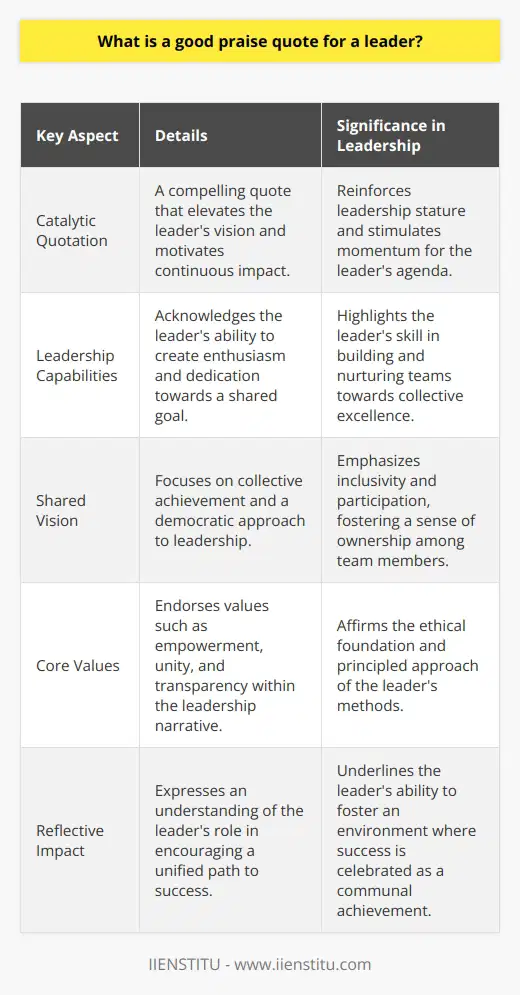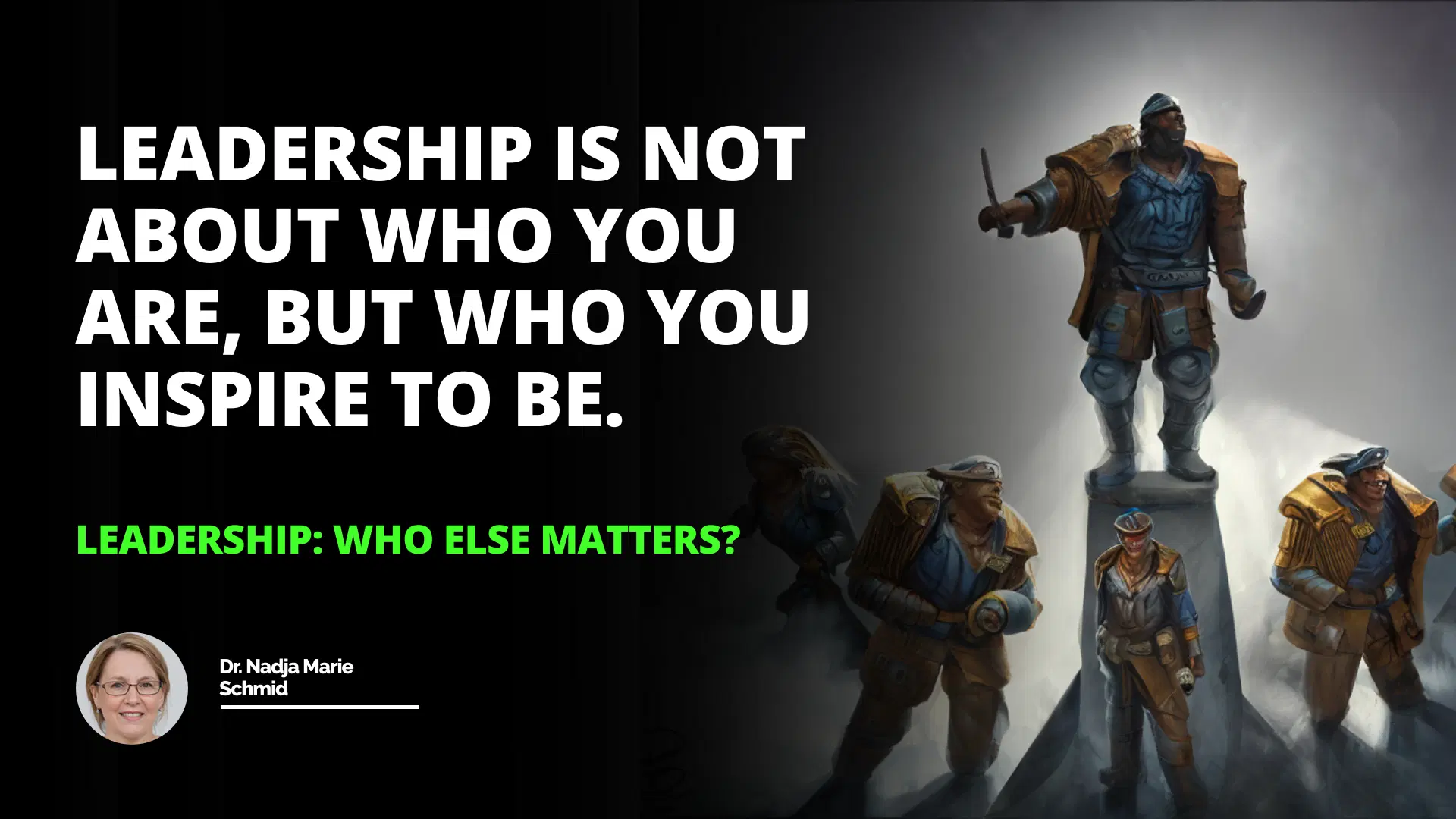
This article discusses different decision-making styles and their implications for stakeholder alignment. It explains how top-down decision-making allows for quick decisions but can lead to a lack of stakeholder alignment. On the other hand, bottom-up decision-making allows for more input from employees but can be slow and inefficient. It also suggests that organizations should strive for a middle ground between the two extremes to ensure stakeholder alignment.
Introduction
Top-Down Decision-Making
Bottom-Up Decision-Making
Middle Ground
Conclusion
Introduction: In the business world, decisions are made by leaders. But who else matters when it comes to making decisions? This article will explore decision-making styles, their implications for stakeholder alignment, and how to best understand an organization's decision culture.
Top-Down Decision-Making
In a top-down decision-making style, critical decisions are made by a few people at the top and then handed down through the ranks. This decision-making style allows for quick decisions but can lead to a lack of stakeholder alignment. In addition, without input from lower-level employees, decisions can be made without considering the full implications.
Bottom-Up Decision-Making
In a bottom-up decision-making style, employees make decisions at the organization's lower levels. This decision-making style allows for more input from employees but can be slow and inefficient. Without clear direction, decisions can be made without considering the organization's overall goals.
Middle Ground
Organizations that can reconcile the extremes of top-down and bottom-up decision-making can meet somewhere in the middle. This decision-making style allows for input from both the top and the bottom, leading to more informed decisions. It also provides for more stakeholder alignment, as all levels of the organization are involved in the decision-making process.
Conclusion: Decision-making styles vary from organization to organization, and understanding an organization's decision culture is critical to ensuring stakeholder alignment. Top-down decision-making allows for quick decisions but can lead to a lack of stakeholder alignment. Bottom-up decision-making allows for more input from employees but can be slow and inefficient. Organizations that can reconcile the extremes of top-down and bottom-up decision-making can meet somewhere in the middle and ensure stakeholder alignment.
Leadership is not about who you are but who you inspire others to be.
Related Course: Leadership Course
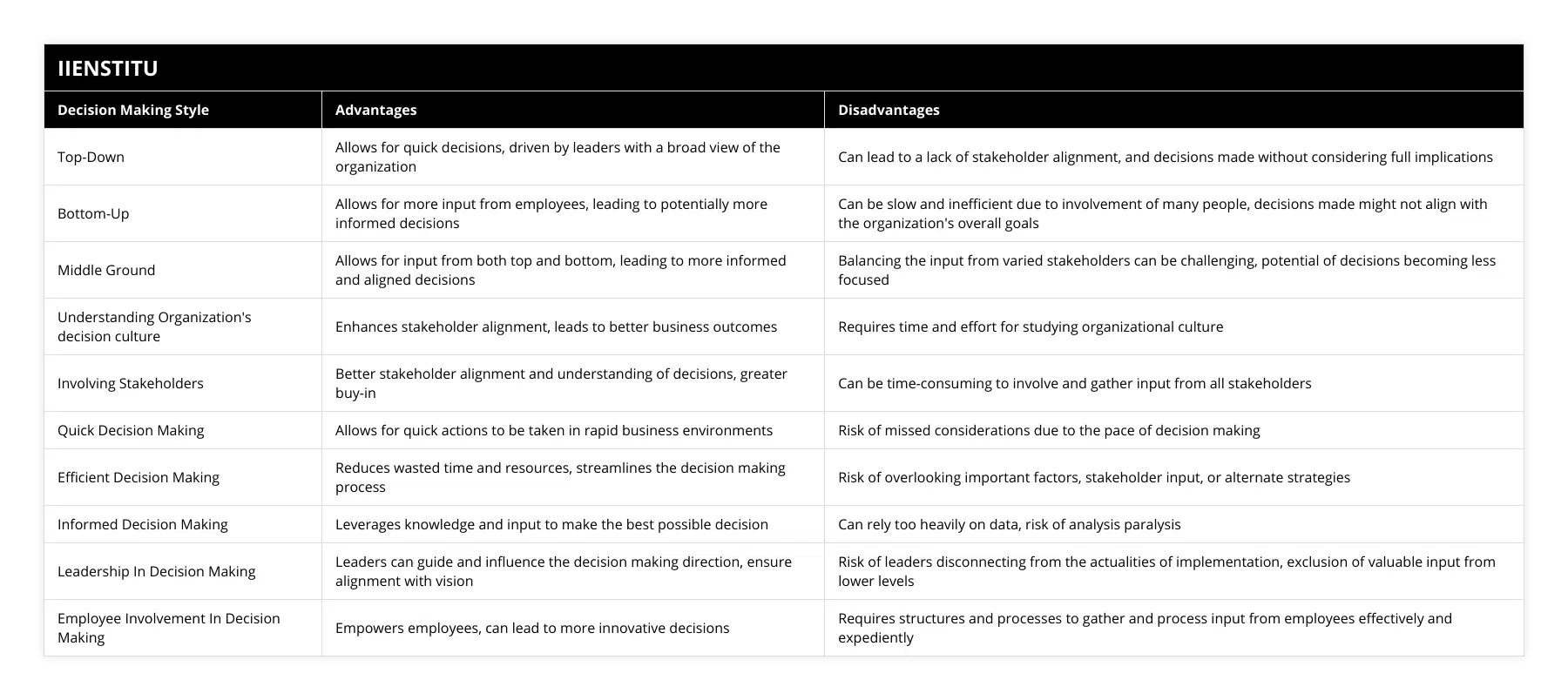
Frequently Asked Questions
What are the implications of top-down decision-making for stakeholder alignment?
Recent studies have shown that top-down decision-making has significant implications for stakeholder alignment. Stakeholder alignment is a critical element of successful project management and business operations. It ensures that all stakeholders have a shared vision and agree on what needs to be achieved. Thus, it is essential to understand how top-down decision-making affects stakeholder alignment.
Top-down decision-making involves decisions at the top of the organizational hierarchy and then communicated throughout the organization. This can be beneficial in certain circumstances, as it allows the organization to quickly and efficiently make decisions that can be implemented. However, it can also be problematic, as stakeholders may not be consulted or informed of the decision, leaving them in the dark and unable to align themselves with the organization’s goals and objectives.
The implications of top-down decision-making for stakeholder alignment can be seen in the potential for misalignment. If stakeholders are not consulted or informed of the decision, they may be unaware of the implications for their role and responsibilities. This can lead to confusion, frustration, and a lack of motivation, which can hurt the organization’s ability to achieve its goals. Furthermore, if stakeholders are not allowed to provide input and feedback, they may feel disconnected from the organization and unable to contribute effectively.
Additionally, top-down decision-making can lead to a lack of trust between stakeholders and the organization. If stakeholders feel that their opinions and ideas are not considered, they may become disengaged and unwilling to invest in the organization’s objectives. This can lead to decreased commitment and a lack of collaboration, which are essential for successful project management and business operations.
Ultimately, while top-down decision-making can be beneficial in certain circumstances, it is essential to consider its implications for stakeholder alignment. Without proper communication and consultation with stakeholders, organizations may find themselves misaligned, mistrusting, and decreased commitment. Therefore, organizations should strive to create a culture of collaboration and shared decision-making to ensure that stakeholders are aligned and invested in the organization’s objectives.
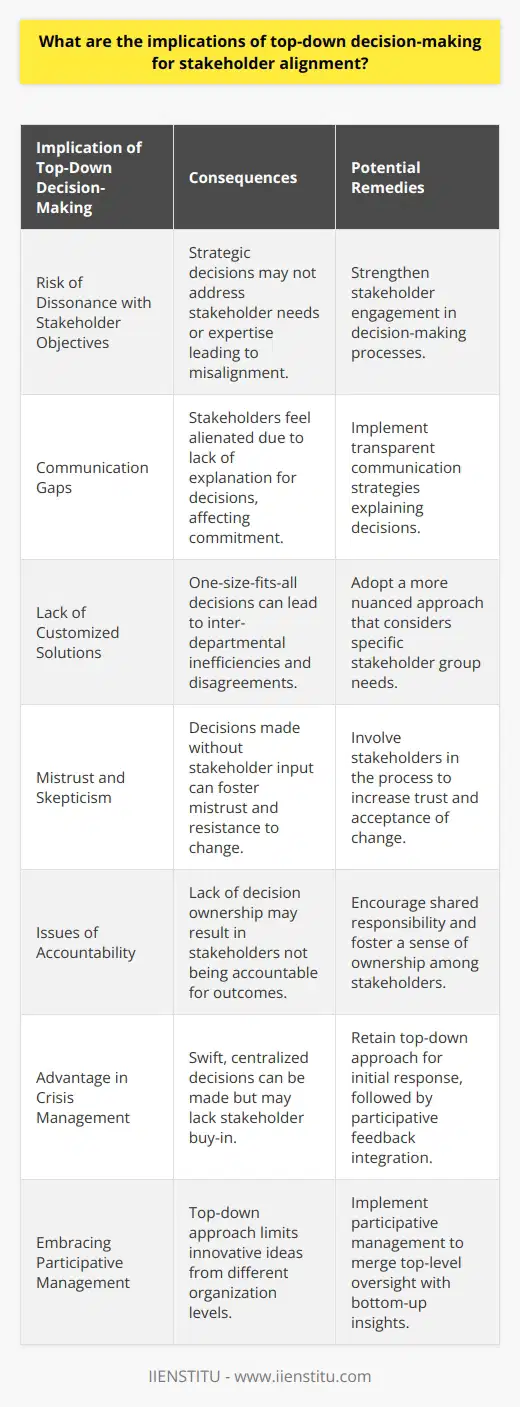
How can organizations reconcile the extremes of top-down and bottom-up decision-making?
The concept of decision-making in organizations is complex, with organizations often facing the challenge of reconciling the extremes of top-down and bottom-up decision-making. Top-down decision-making is the process by which decisions are made solely by those in positions of authority. In contrast, bottom-up decision-making is the process by which members make decisions for the organization at all levels. Both approaches have their merits and drawbacks, and organizations must be able to reconcile the two to ensure that decisions are made effectively and efficiently.
The first step in reconciling the extremes of top-down and bottom-up decision-making is to create an organizational culture that values and encourages participation and collaboration. When individuals at all levels of an organization are allowed to contribute to the decision-making process, it helps to ensure that all perspectives and opinions are taken into account when making decisions. This can create a more inclusive decision-making process and help ensure that decisions are made with the best interests of the entire organization in mind.
Another way to reconcile the extremes of top-down and bottom-up decision-making is to ensure t a clear and compelling communication structure is in place. This allows individuals at all levels of the organization to be informed of the decisions being made and to be able to provide feedback and input. This also allows for a more open discussion of ideas and perspectives, leading to better decision-making.
Finally, organizations should also look for ways to leverage the strengths of both top-down and bottom-up decision-making. For instance, top-down decision-making can be used to set the overall direction and goals of the organization, while bottom-up decision-making can be used to determine the best way to achieve those goals. By combining the two approaches, organizations can ensure that decisions are made promptly and effectively.
In conclusion, they were reconciling the extremes of top-down and bottom-up decision-making requires organizations to create an organizational culture that values and encourages participation and collaboration, ensure precise and compelling communication structure, and look for ways to leverage the strengths of both approaches. By taking these steps, organizations can ensure that decisions are made effectively and efficiently.
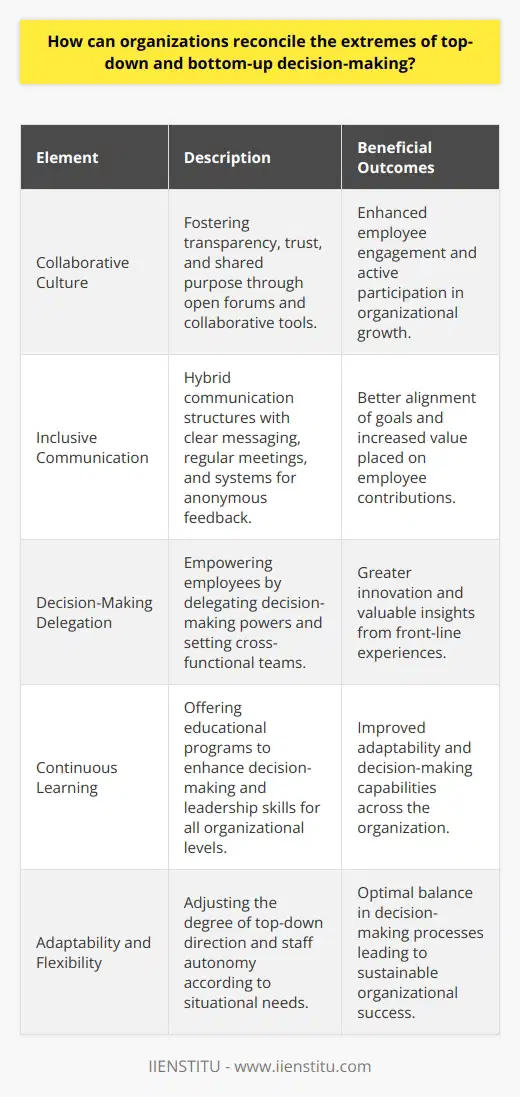
What is the importance of understanding an organization's decision culture in order to effectively lead?
Leadership is an essential factor in any organization, as it is responsible for setting the tone and direction for the organization. To effectively lead an organization, leaders need to understand the decision culture of the organization. This understanding is critical for leaders to make well-informed decisions that benefit the organization's decision-making.
Organization's decision culture refers to the values, beliefs, and norms that guide decision-making within the organization. This culture is createorganization'sorganiza'ion’s remembers members' actions and behaviors. For exampleorganization'srganization’s leaders frequently make decisions without considering input from other stakeholders. In that case, this can create a culture where decisions are made without taking into account the perspectives of others. Therefore, understanding an organization’s decision culture is critical for leaders to ensure that all stakeholders are given a voice in decision-making and that decisions are made considering the needs of all stakeholders.
In addition, understanding an organization's decision culture is essential for leaders to manage organizational change effectively. The difference is a constant in any organization, and leaders need to anticipate and manage changes to ensure the organization's success. Understanding the decision culture of an organization allows leaders to anticipate changes better and ensure that any changes align with the organization's values and goals.
Finally, understanding an organization's decision culture is essential for leaders to communicate effectively with stakeholders and ensure that the organization's decisions are supported. When leaders understand an organization's decision culture, they can better communicate their choices and ensure stakeholders understand why certain decisions were made. In addition, this understanding helps to foster trust and respect between stakeholders and the organization, which is critical for the success of an organization.
In conclusion, understanding an organization's decision culture is essential for effective leadership. By understanding the values, beliefs, and norms that guide decision-making within the organization, leaders can better make well-informed decisions, manage change more effectively, and ensure that stakeholders support decisions. Therefore, leaders must take the time to understand an organization's decision culture to lead the organization effectively.
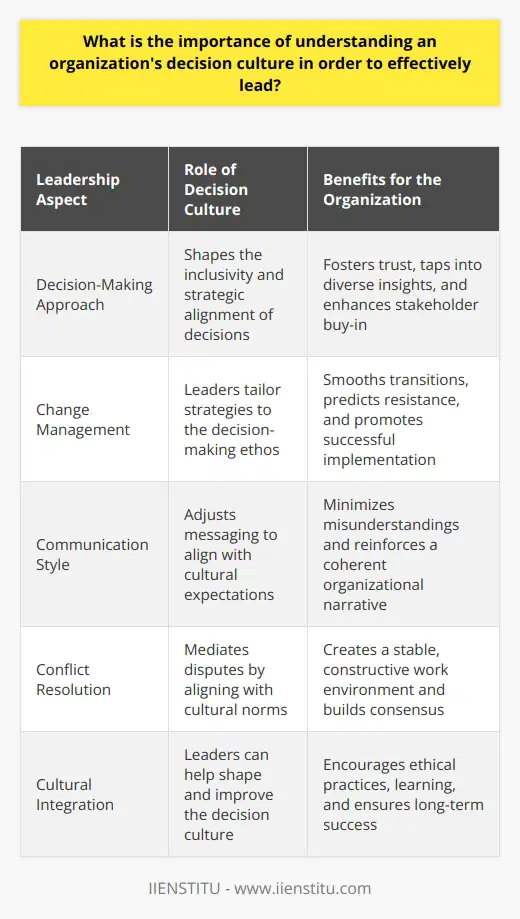
What are the key factors that contribute to effective leadership in promoting organizational success?
Significance of Effective Leadership
Among the key factors contributing to effective leadership in promoting organizational success, three stand out as crucial: clear communication, adaptation to change, and employee motivation. First, clear communication plays a significant role in transmitting the leader's vision and objectives throughout the organization, which fosters a sense of direction and unity among team members. As a result, employees understand the company's goals and align their individual efforts accordingly, enhancing overall productivity and performance.
Adaptability to Change
Second, effective leaders must be adaptive and flexible in the face of change. With business environments constantly evolving, a leader's ability to anticipate and react to these shifts is crucial to maintaining organizational success. They must be willing to re-evaluate strategies, embrace innovative practices, and adjust to changing circumstances. By doing so, the leader not only ensures the organization does not stagnate but also instills an adaptable mindset throughout the team. This, in turn, enhances their capacity to stay competitive and thrive in a dynamic landscape.
Empowering Employee Motivation
Lastly, an effective leader must motivate and engage employees, fostering a strong organizational culture and a shared sense of achievement. This can be achieved through various means such as providing constructive feedback, recognizing achievements, offering opportunities for development, and promoting a sense of ownership and autonomy among staff. A motivated workforce not only drives increased productivity but also enhances an organization's ability to attract and retain top talent. Furthermore, employee engagement and satisfaction are vital in creating a positive work environment, leading to increased collaboration and reduced instances of counterproductive behaviors.
In conclusion, effective leadership plays an essential role in promoting organizational success. This can be achieved through various means such as transparent communication, adaptability to change, and employee motivation. By focusing on these factors, leaders can create an environment that allows their organization to flourish and maintain a competitive edge in the ever-evolving business landscape.
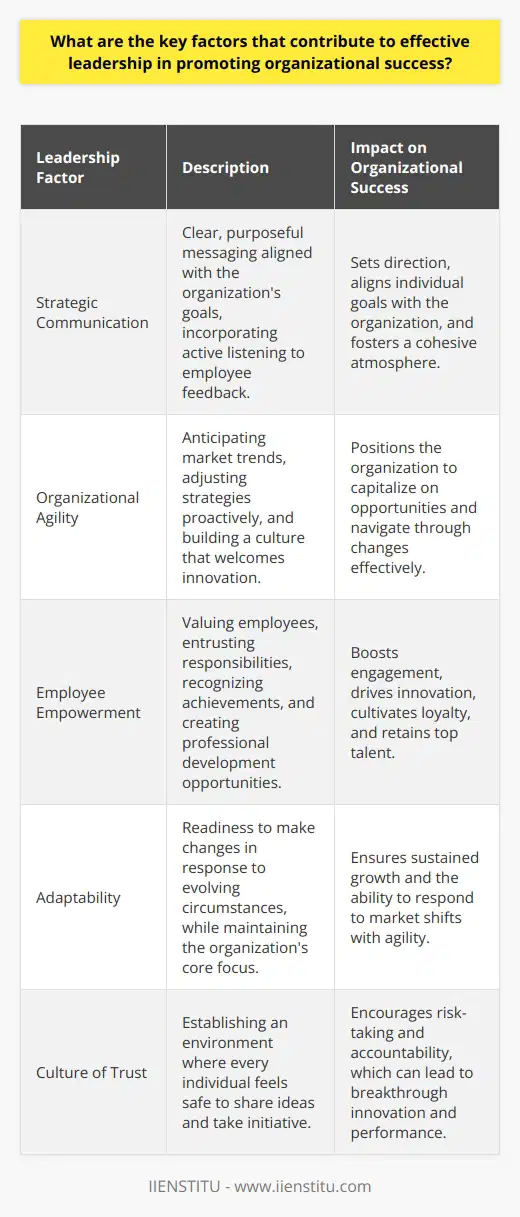
How do various leadership styles impact employee engagement and performance?
Leadership Styles and Employee Engagement
One crucial element in fostering high levels of employee engagement and performance is the leadership style employed within an organization. Several leadership styles significantly influence these aspects, including transformational, transactional, autocratic, and laissez-faire leadership.
Transformational Leadership
In transformational leadership, the leader strives to inspire their employees, emphasize their growth and development, and establish a clear vision. This approach leads to increased motivation, creativity, and commitment among team members. Evidence suggests that this style dramatically improves employee engagement and performance, as it fosters a positive work environment and cultivates trustworthy relationships between the leader and employees.
Transactional Leadership
Transactional leadership focuses on providing clear expectations, setting straightforward goals, and rewarding or punishing employees based on their performance. This style creates a structured work environment, where employees understand their responsibilities and the necessary steps to achieve success. However, this approach may limit creativity and innovation, as it often encourages employees to meet the minimum requirements. Despite these potential drawbacks, transactional leadership proves to be helpful in maintaining employees' engagement and performance, especially in task-oriented situations.
Autocratic Leadership
Autocratic leadership involves the leader making all decisions without consulting their employees, and offering little or no opportunity for feedback. While this style may be useful in crisis situations or when quick decisions are needed, it can lead to low employee engagement and performance over time. Employees may feel undervalued, lack motivation, and experience burnout under this leadership style.
Laissez-faire Leadership
Under laissez-faire leadership, employees have maximum autonomy and control over their work, with the leader providing minimal guidance or direction. Though this style can foster creativity and innovation, it might also result in a lack of structure, poor communication, and unclear expectations. Employees may struggle with prioritizing tasks or coordinating efforts, ultimately leading to lower engagement and performance.
In conclusion, a leader should recognize the importance of adapting their leadership style based on the context and the team's needs to foster high employee engagement and performance. There is no one-size-fits-all approach, but understanding the impact of different leadership styles can empower leaders to create a healthy and productive work environment.
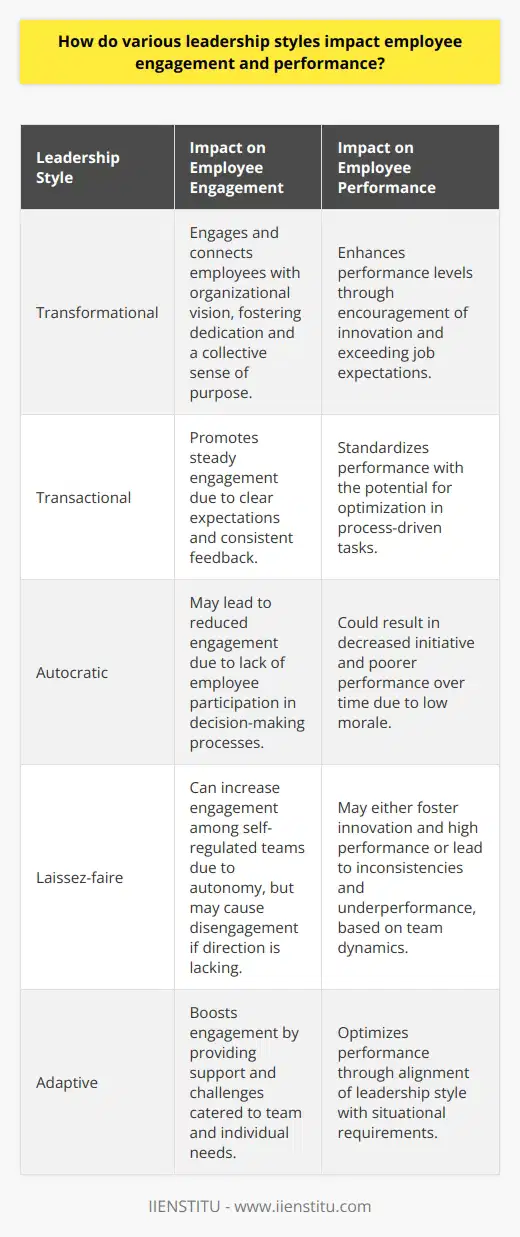
What are the potential consequences of poor leadership within an organization?
**Consequences on Organizational Performance**
Poor leadership within an organization can significantly affect overall performance. Inefficient decision-making processes lead to low productivity, resulting in the organization's inability to achieve its goals. Furthermore, poor management can affect the relationship among team members, causing divisions and conflicts that undermine the cohesive functioning of the organization.
**Impact on Employee Morale and Engagement**
The presence of poor leadership can negatively impact employee morale and engagement. Poor leaders often do not inspire or motivate their employees, leading to a lack of initiative, enthusiasm, and commitment. Additionally, weak leaders may have difficulty providing clear guidance and feedback, leaving their employees feeling undervalued. This lack of support can lead to high employee turnover, resulting in additional costs for hiring and training new staff members.
**Loss of Trust and Credibility**
Incompetent leadership can erode trust and credibility within an organization. Employees who believe that their leader is ineffective or lacks integrity are less likely to invest in the organization's vision and goals. This skepticism affects employees' willingness to collaboratively work toward shared objectives. The loss of trust can also extend beyond the organization, impacting relationships with clients, customers, and stakeholders.
**Financial Implications**
The consequences of poor leadership on financial performance may include reduced revenue and profits. Organizations led by incompetent leaders struggle to operate efficiently, leading to increased costs, waste, and potentially lost business opportunities. Additionally, a diminished reputation due to poor management can negatively impact the organization's ability to attract new clients and maintain existing relationships.
**Innovation and Adaptability Challenges**
Poor leadership directly affects an organization's capacity for innovation and adaptability. Ineffective leaders often demonstrate resistance to change and may be unable to identify opportunities for growth and improvement. The lack of innovative thinking can hinder an organization's ability to remain competitive and adapt to changing market conditions.
**Conclusion**
In conclusion, poor leadership within an organization can lead to a multitude of negative consequences that extend to employees, overall performance, and financial stability. Understanding these potential consequences is essential for organizations seeking to foster strong, effective leadership that contributes to a thriving, successful organization.
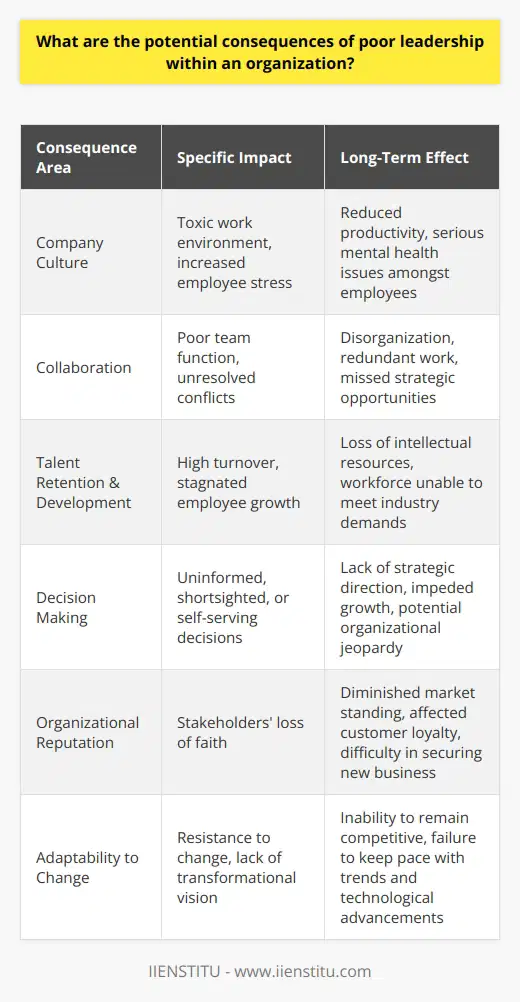
What are the 4 different leadership styles?
Subheadings: Autocratic Leadership, Transformational Leadership, Servant Leadership, Laissez-faire Leadership
Autocratic Leadership
One prevalent leadership style is autocratic leadership. In this style, decision-making and control lie solely with the leader, allowing minimal input from subordinates. While often considered outdated, it can be effective in situations requiring rapid decisions or with inexperienced team members.
Transformational Leadership
Transformational leadership, on the other hand, focuses on inspiring and motivating followers to achieve their full potential and exceed their own expectations. This style emphasizes clear communication, shared goals, and empowering team members, thus enabling high levels of innovation and successful outcomes.
Servant Leadership
Another style is servant leadership, where leaders prioritize listening to their team's needs and fostering an inclusive, supportive environment. By placing their focus on individual and collective growth, servant leaders aim to make a positive impact on people first, with the ultimate goal of improved organizational performance.
Laissez-faire Leadership
Lastly, laissez-faire leadership is a hands-off approach, in which leaders delegate responsibilities and allow team members to work autonomously. This style works best with highly skilled, self-motivated individuals, but may lead to lack of direction and oversight if not managed carefully.
Overall, understanding and adapting one's leadership style to the needs of the team and organization can improve group cohesion, productivity, and job satisfaction. Choosing the appropriate leadership style should depend on factors such as team dynamics, individual capabilities, and organizational context.
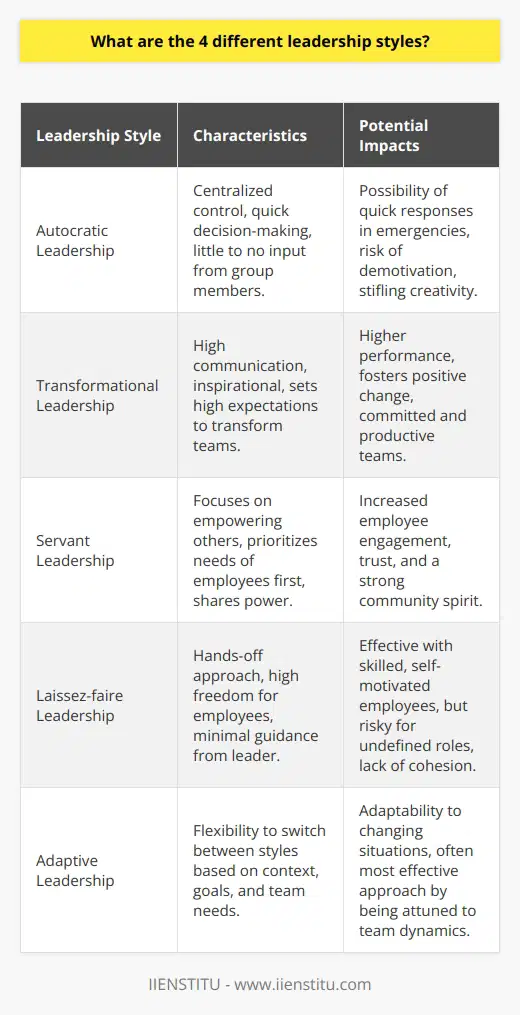
What is a good quote about leadership?
Quote Selection
A powerful quote about leadership that encapsulates its essence comes from pioneering management consultant and author Peter F. Drucker, who said, 'Management is doing things right; leadership is doing the right things.'
Significance of the Quote
This quote highlights the distinction between management and leadership by emphasizing the ethical component of leadership. While effective management ensures that tasks are completed efficiently, outstanding leadership entails recognizing and prioritizing the morally right actions.
Responsibility of Leaders
The quote implies that a leader's responsibility goes beyond managing technical aspects and delves into considering the ethical implications of their choices. By fostering commitment, motivation, and ethical behavior, a good leader empowers their team to make genuine progress.
Focus on the Right Things
Drucker's quote also emphasizes that great leaders should be steadfast in their pursuit of morally sound, purpose-driven goals rather than chasing short-term gains or superficial results. This approach helps leaders and their teams maintain a clear vision, thus promoting long-term success.
Impact on Followers
By focusing on doing the right things, leaders inspire confidence, trust, and loyalty among their followers. The quote suggests that team members who see their leaders consistently making conscious ethical decisions are more likely to develop a strong sense of commitment and purpose themselves.
In conclusion, Drucker's quote encapsulates the essence of true leadership by differentiating it from mere management. The axiom reminds us that remarkable leaders not only ensure task completion and efficient goal achievement but also prioritize ethical decision-making and the pursuit of the right goals. This leadership style positively influences those who follow such leaders, creating a strong sense of purpose and commitment that ultimately drives success.
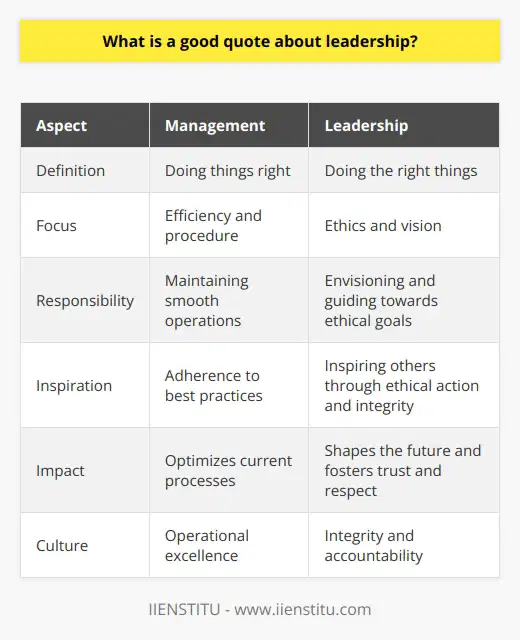
What is a good praise quote for a leader?
Determining a Suitable Praise Quote
A meaningful praise quote has the potential to inspire both the leader themselves and the people who follow them. A good praise quote for a leader should satisfy a few essential criteria, which include being specific about the qualities being praised, using authentic expressions to convey admiration, and reflecting the leader's values and beliefs.
Highlighting Qualities Worthy of Applause
The quote should focus on the positive attributes of the leader, particularly those that differentiate them from others. Therefore, an ideal quote would emphasize qualities such as courage, wisdom, humility, and the ability to guide and inspire individuals. For example, 'The function of leadership is to produce more leaders, not more followers' by Ralph Nader. This quote acknowledges the role of empowering others in successful leadership.
Emphasizing Authenticity in Admiration
The quote should be genuine, coming from a place of authentic admiration. Empty flattery or generic compliments fail to make a lasting impact both on the leader and their followers. Consider a phrase like, 'Innovation distinguishes between a leader and a follower' by Steve Jobs. This quote appreciates the creative aspects of leaders as the driving force of development and transformation, which are often ingrained in the work of successful leaders.
Aligning with the Leader's Values and Beliefs
To resonate profoundly with the praised leader, the quote should reflect their philosophy and principles. By doing so, it assures them that their work is understood, valued, and appreciated on a deeper level. As an example, 'The best leaders are those most interested in surrounding themselves with assistants and associates smarter than they are' by John C. Maxwell. This quote highlights the trait of humility and continuous learning in an effective leader, ultimately connecting with those who share a similar approach to leadership.
In conclusion, a good praise quote for a leader should be detail-focused, genuine, and consistent with the leader's convictions. By acknowledging their specific traits and values, such quotes become influential and inspiring for both the leader and their followers.
